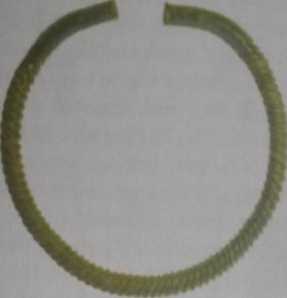75488 P1190362
280 Eltbwlu Małgorzata Kłosińska
lands (Oedl 1991: 1391. and the specimens from the discnssed territory have evcn cl equivalcnts in the nocthcm, Pomcranian zonę cmbraced by the Lusatian cul-ture (ifrwtin: 87. Fig. 46:4. 8). We can also encounter thcm for examplc in the aren of Lower Saxony. where thcy occur under the namc of “Steirnbke" and “Dehnscn" \ anations and arc dated to the older period of the early Iron Age (Laux 1976: 131. 132. Plalc 41: 802-809). as well as in many plnces in Central Europę, c.g. in south Germany and Bohemia. Probably a similarly widespread central Euro pean origin in the Bronze Age or the early Iron Age. should be ascribed to often cncounlered sptral-headcd pins: sonie cxamples of thcm comes also from the Lublin region: from Gródek, commune of Hrubieszów (Rogatko 1990: 190-192, Fig. 10) and from unknown places (Fig. 4: 10, II). Howevcr, it is not unlikely u pair of scal-ended bracelets with lines on an oval bow (Fig. 4: 21. 22), discovcrcd in an unknown place in the Lublin region may reflect the connections betwecn thal region and Silesia, where m the HaC period similar specimens. taking pattems from Hallstatt cirele finery. appeared e.g. in graves (Gedl 1991: 88. 91, 139, Fig. 34: 4, 5).
The western direction of the Lublin region*s connections was inaintaincd in the younger period of the early Iron Age. In Polish lands, in the aren cmbraced by the Lusatian culture. in the HD phase, especially the centrc located in west Great Roland and Kuyavia was active. where local design of bronze finery was devcl-uped lt is belicved. that the objects typical for that zonę were, among others. double-spiral-hcaded pins. Icg-guards of Stanomin typc, bracelets of one and a half coiis. and torded nccklaces with various ends (Kostrzewski 1964: 20-24). Not questioning the primacy of the producers from Great Poland and Kuyavia in casting and distribution of such finery, we shall mention here, that not all the pattems were original. as voluted pin heads or thin torded necklaccs. known al-neady in central Europcan Tumulus and Umfield culture arcas (cf. Kubach 1977: 250 263. Platę 41: 526; Weiss 1995: Platę 23: 3; Wels-Weyrauch 1978: 156-158. Piałeś 64. 65). All thosc objects appeared also in the Lublin region most probably in the second half of the early Iron Age. We should mention herc a pin from Kołemczycc. commune of Dorohusk (Fig. 4: 9). one of a pair of Stanomin typc leg-guards found in Zemborzyce. commune of Lublin (Fig. 4: 17) and a rcccntly discovered bracelet of one and a half coiis with poorly prcscrvcd slanting cross decormtion patiem from Turkowice, commune of Werbkowice (Fig. 4: 20).
Some of the Lublin region massive torded nccklaces with various ends could rally imvt from Kuyasia. It refers abovc all to an excmplar from Wakijów, com-mune of Tyszowce (Fig. 4: I). bccause a significant conccntration of nccklaces with flattened ends has been noted in this pnrticular aren for a long timc (Ko-strzewski 1954. Map 111; 1964: 21; Poklcwski 1954: 271). It is also not unlikely. that Ihe ołhcr torded nccklaces from the Lublin region, such as a spccimcn from w unknown place j Fig. 4: 2). from WoZuczyn, commune of Rachanie (Fig. 4: 3) and iwo examplcs from Radecznica, commune loco (Fig. 4: 3, 4; Fig. 5), were «s well produced in Kuyavia, although analogous forms may be shown in Silesia or in Liulc Polami (cf. Kłosińska. Kurztpkowska, Nogaj-C'buchaj 2005: 247- 252).

Fi {.Radecznica. commune loco Uron/c nc&laccs iMnauipFMcdgnw ftomihccaity Im A|t
(pitol by M Kottow-tlki)
In this conteM, a necklncc willi slightly flattened ends from Radecznica (Fig. 4:4) 'OcniN to be particularly iiitcrcsting. It was imulc of bronze alloy contaimng a Hgnilicant amount of leud admixturc. Thnt tael leads lo a hypothcsis (hal ii was madc in Upper Silesia Linie Polami area. where that ore was cxploited from the early Iron Age (Kostrzewski 1953: 204; Dąbrowski 1982: 239). The connections of the Lublin region with Upper Silesia - Linie Polami group of the Lusatian cul* twe arc rcflcctcd probubly also by tw o leg-guards of Sącz typc from Woiuc/yn, commune of Rachanie (Fig. 4: 18-19),
- Olher unique bronze finery. dated to the sccond phasc of the early Iron Age and found in the Lublin region, lit in ccnlral-Luropean design of that trute Pro bably the best example of it is u spectacle-spiral brooch w ith a mouihlc, próba* biy iron tongue (Fig. 2: 12) which was a part of a hoani in Dcszkowice Drogie, pntmino of Sułów. Similar brooches were unito popular bolh in the Umliekl culture cirelc and in llallstutl worki, probahly heemise they were e.isy to be pio-dueed and besides lliey Inni u praetrcal and nesthelie \nluc and rapressed sonie (ymbolic mcaning (cf. Kłosińska 2004c; 29 31). IW-piece aitolkts, sonie with
Wyszukiwarka
Podobne podstrony:
P1190362 280 Eltbwlu Małgorzata Kłosińska lands (Oedl 1991: 1391. and the specimen
21326 P1190368 292 Elżbieta Małgorzata Kłosińska Michalczyk 3 Wiłgat T„ 1998. Stosunki wodne Lubelsz
P1190364 284 Elżbieta Małgorzata Kłosińska Together w uh those changes, connccted
P1190364 284 Elżbieta Małgorzata Kłosińska Together w uh those changes, connccted
P1190364 284 Elżbieta Małgorzata Kłosińska Together w uh those changes, connccted
P1190366 2SS Elżbiet* Małgorzata Kłosińska ■HhH regua vu ibc Zamość VaIIey, as a r
31542 P1190363 2X2 Elżbieta Małgorzata Kłosińska tran element*. arc placcd m the Mm and HaD periods
71606 P1190365 286 Ellbida Miigonatt Kłosińska The most iniensive contacts liriked the Lublin region
P1190365 286 Ellbida Miigonatt Kłosińska The most iniensive contacts liriked the Lublin region with
52103 P1190360 276 EttbiM Małgorzata KłociAaka «nt aot - aa it aectns - u meaningf
280 Z. KORUBA ET AL. six degrees of freedom in the discrete model of the system described by ana-lyt
więcej podobnych podstron